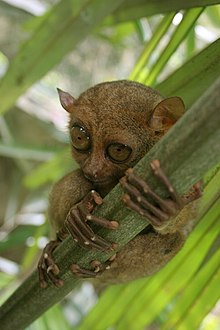Tarsiidae
| Tarsiers Temporal range: 45–0 Ma Middle Eocene to Recent |
|
|---|---|
 |
|
| Philippine tarsier (Carlito syrichta) | |
| Scientific classification | |
| Kingdom: | Animalia |
| Phylum: | Chordata |
| Class: | Mammalia |
| Order: | Primates |
| Suborder: | Haplorrhini |
| Infraorder: | Tarsiiformes |
| Family: |
Tarsiidae Gray, 1825 |
| Type genus | |
|
Tarsius |
|
| Genera | |
Tarsiers are haplorrhine primates of the family Tarsiidae, which is itself the lone extant family within the infraorder Tarsiiformes. Although the group was once more widespread, all the species living today are found in the islands of Southeast Asia.
Fossils of tarsiiform primates are found in Asia, Europe, and North America, with disputed fossils from Africa, but extant tarsiers are restricted to several Southeast Asian islands, including the Philippines, Malaysia, and Indonesia. The fossil record indicates that their dentition has not changed much, except in size, in the past 45 million years.
Within the family Tarsiidae, there are two extinct genera, Xanthorhysis and Afrotarsius. However, the placement of Afrotarsius is not certain, and it is sometimes listed in its own family, Afrotarsiidae, within the infraorder Tarsiiformes, or considered an anthropoid primate.
So far, four fossil species of tarsiers are known from the fossil record:
The genus Tarsius has a longer fossil record than any other primate genus, but the assignment of the Eocene and Miocene fossils to the genus is questionable.
The phylogenetic position of extant tarsiers within the order Primates has been debated for much of the 20th century, and tarsiers have alternately been classified with strepsirrhine primates in the suborder Prosimii, or as the sister group to the simians (Anthropoidea) in the infraorder Haplorrhini. Analysis of SINE insertions, a type of macromutation to the DNA, is argued to offer very persuasive evidence for the monophyly of Haplorrhini, where other lines of evidence, such as DNA sequence data, remain ambiguous. Thus, some systematists argue the debate is conclusively settled in favor of a monophyletic Haplorrhini. In common with simians, tarsiers have a mutation in the L-gulonolactone oxidase (GULO) gene, which confers the need for vitamin C in the diet. Since the strepsirrhines do not have this mutation and have retained the ability to make vitamin C, the genetic trait that confers the need for it in the diet would tend to place tarsiers with haplorrhines.
...
Wikipedia
